Going Where No Sheep Has Gone Before
Clark Roberts never expected to be a shepherd, but as Noble continues to integrate regenerative changes, he’s learning to manage a whole new type of grazing animal.
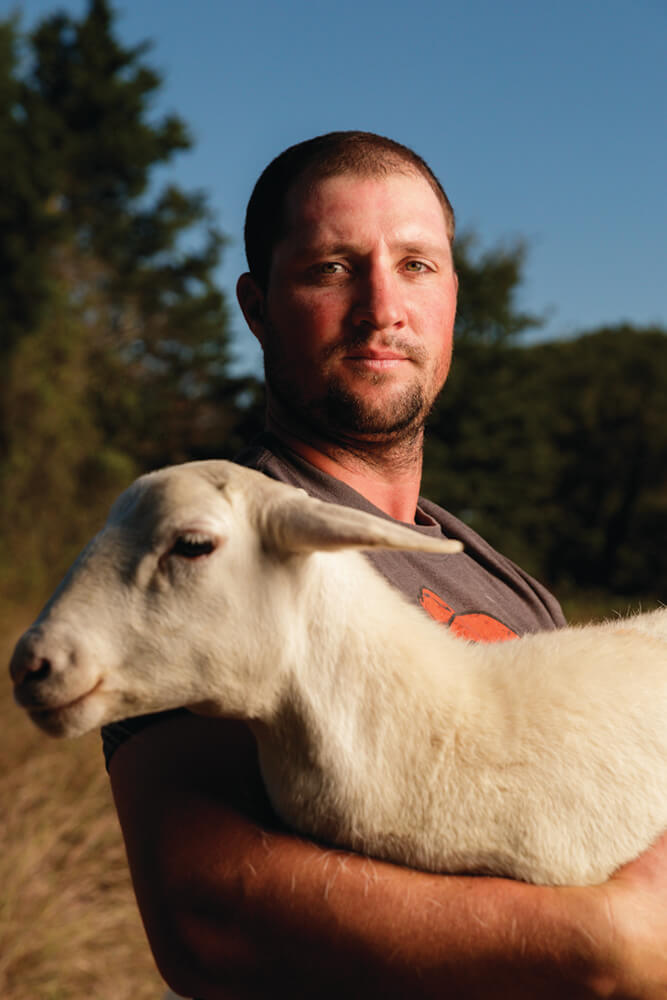
The sheep at Coffey Ranch are rotationally grazed using adaptive multi-paddock (AMP) grazing.
Clark Roberts usually traverses the landscape of Coffey Ranch at a breakneck speed, but today he’s taking it slow.
Roberts, the ranch facility manager for Noble Research Institute’s Coffey Ranch, rolls down a dusty path leading to the flock of sheep in his side-by-side all-terrain vehicle. He periodically glances over his shoulder to make sure that Lucy and Ethel, the new 5-month-old guard dogs in training, are still following him.
Noble introduced 39 sheep to Coffey Ranch in spring 2021, and Roberts has been their den mother. Now, the size of the flock has doubled, and Roberts is bringing in the pair of young pups as reinforcements for the two experienced guard dogs, Wilson and Amos.
As Roberts, Lucy and Ethel arrive at their new flock, it’s easy to see the sheep’s effect on the land. Sheep are selective grazers that will find and eat many different species of grass and forbs. At Coffey, the flock has cleared out an area in the shade to lay and rest. A wall of taller grass surrounds and partially obscures them from view.
Lucy and Ethel immediately careen toward the flock with an exuberant energy only possessed by puppies. The sheep peer over the tall grass from their clearing with a healthy look of skepticism. (Sheep are not innately trusting creatures, Roberts explains.) The flock took three weeks to get used to Roberts, and even longer to become accustomed to his ATV. The new puppies are unwelcome additions.
Lucy reaches the flock first and is promptly met with a sudden “smack” to her snout from the head butt of one of the sheep. She emits a yelp before bounding back in the direction she came, tail tucked between her legs and Ethel not far behind her. Wilson and Amos look on quietly, before calmly sauntering back to their place among the herd.
Integrating two puppies into a flock of sheep is just the latest in a long list of firsts that Roberts has accomplished in the past six months. Noble decided to introduce sheep into Coffey Ranch as part of its overall pivot toward regenerative ranching, the goal of which is to restore degraded grazing lands by applying the six principles of soil health (see page 29). With the change in focus, Noble is revolutionizing the way it manages its ranches, from the type of livestock used to every decision being centered on rebuilding the soil.
Of course, there have been a lot of lessons to learn, for both dogs and humans.
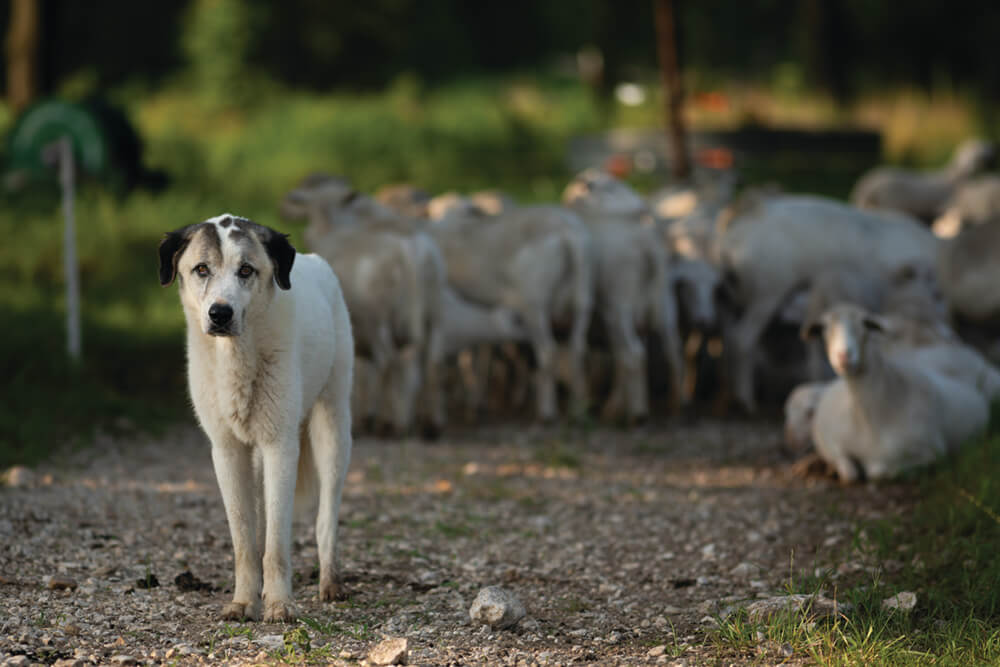
For the Good of the Ranch
Noble’s shift to regenerative ranching has challenged everyone. Roberts had little prior experience practicing regenerative ranching before the transition, and even less with herding sheep. But stepping out of one’s comfort zone is often necessary for the good of a ranch, and sheep — like other grazing animals — can play a critical role in building soil health.
The new flock helps Coffey Ranch follow the soil health principles, especially increasing diversity and, of course, integrating livestock. Sheep utilize a larger amount of forbs than cattle, allowing for greater use of all available forages on the ranch. The sheep also contribute by adding additional manure, which decomposes into a natural fertilizer, further boosting the health of the soil. But most importantly, sheep increase the biodiversity of the land, a vital principle of soil health.
“Diversity is key in all areas of the ranch,” Roberts says.
“We want diversity in the soil, diversity in our forages, diversity in our wildlife and our livestock.”
While cattle have traditionally been Coffey’s primary livestock, the newly added sheep have complemented the cattle’s grazing patterns. Sheep will eat plants in the forage mix that cattle pass up. The diversity in livestock has helped Coffey capitalize on all of its natural forage, leading to further diversity in other areas of the ranch.
All of these benefits exemplify what regenerative ranching is all about: putting nature to work for your ranch, not against it.
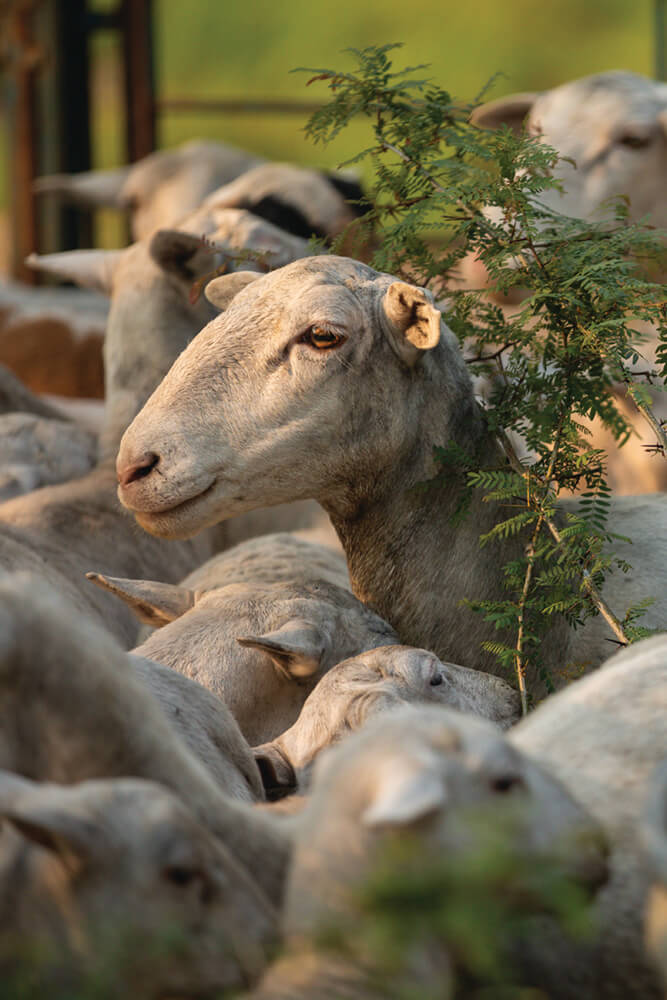
A Christmas Story
Coffey’s journey with regenerative ranching hasn’t been easy. Roberts encountered and overcame numerous challenges early on. He quickly learned the principles of regenerative ranching (it’s a mindset, not a recipe) and studied the sheep’s movement and foraging patterns so he could best utilize them. A few months later, Roberts says he realizes the learning has just begun.
“I’m still learning, figuring out the flock’s foraging behavior and little idiosyncrasies,” Roberts says. “It’s a huge learning curve that I’m still trying to figure out.”
Another challenge that Roberts immediately encountered was keeping the flock fenced into their paddock. Roberts used a single strand of electrified poly wire, but the sheep could pass underneath the wire without feeling any warning shock due to their hair’s insulation and their nimbleness.
Keeping the flock in place was important not just for the adaptive multi-paddock grazing strategies used on the ranch, but also for the animals’ safety. When left to their own devices, sheep can tend to make life-ending decisions.
To stop the sheep’s jailbreaks, Roberts had to ensure that the wire would hit the sheep’s nose. It was the only way they would feel the zap. Once Roberts had the wire set up correctly, the flock quickly came to the sudden realization that the fencing was not to be trifled with.
“There were five of them (lambs) standing there in front of the poly wire when they first went out,” Roberts says. “It was like that Christmas story where the kids say, ‘You won’t touch your tongue to the pole. You won’t do it.’ One of those suckers went up there and hit his nose to it and jumped back. The other ones were standing there going, ‘What happened?!’ before they turned around and took off.”
Safe to say, Roberts’ fencing problem was solved.
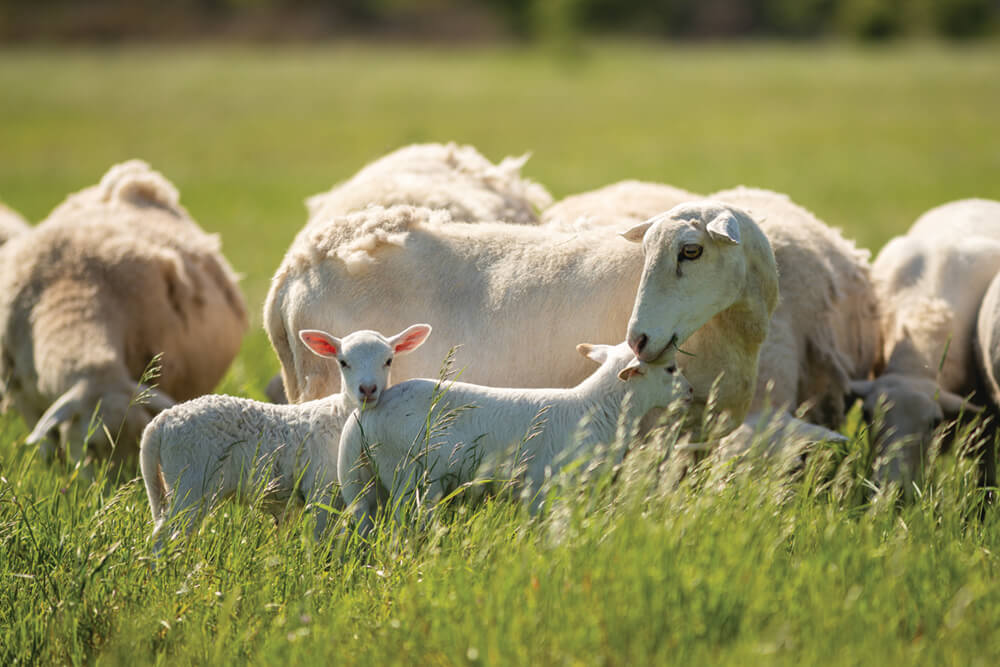
Count ‘em: More Sheep On The Way
While Roberts wrangled with some initial challenges, adding the sheep has been crucial in converting Coffey Ranch to regenerative ranching. His short time with his flock has helped him expand his husbandry abilities. He has become more observant and more attuned to their habits and needs. In turn, the flock has become easier to manage and more self-sufficient.
Noble specifically chose hair sheep over wool sheep due to their self-sufficiency. Katahdin and Dorper ewes, the type of hair sheep Noble run, are more parasite-resistant and hardier than wool sheep, capable of living comfortably in varying climates. Additionally, while wool sheep must be sheared at least once a year, hair sheep do not require any shearing.
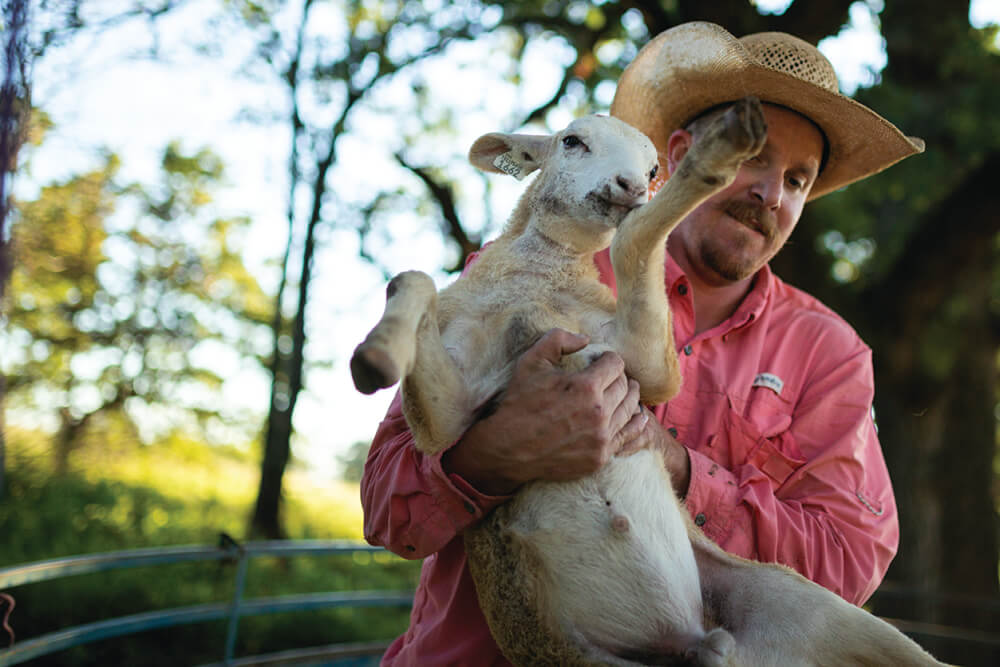
Keep up with Clark, Lucy and the lambs
We invite you to follow our journey of regenerating the land. See more behind-the-scenes content from Coffey Ranch on our Instagram page.
Hair sheep are more cost-efficient when compared to wool sheep. Wool sheep require dewormer four to five times a year, while hair sheep require none. Hair sheep can also live off the land. They eat plants the cows usually won’t eat, saving the ranch money.
“Hair sheep require little or no feed if you have enough forage, and Noble is focused on grazing animals, so it all makes sense,” says Kevin Lynch, a Noble research associate who has worked with sheep on his own ranch for the better part of 35 years. “Wool sheep need to be fed grain and hay throughout the year. Hair sheep will graze on weeds or grass. You don’t have to intensely manage them.”
Roberts’ most critical takeaway in his novice shepherding career: the flock’s potential for sustained profitability. Sheep are capable of lambing twins or triplets, and it doesn’t take long for lambs to be ready for market after birth, meaning they can quickly become profitable.
“In four months, you can take them to market and ship the lamb,” Lynch says. “Usually, with any of the hair sheep, at 50 pounds you are ready to go to market.”
Moreover, because hair sheep feed on weeds (i.e., plants you don’t want) and forbs, the reduced need for chemical inputs can have an additional soil benefit and reduce costs for producers. If properly managed, hair sheep can bring regenerative and monetary benefits to a ranch in quick order.
Noble aims to eventually grow its Coffey flock of hair sheep before potentially introducing flocks to its other ranches.
No Kidding: Goats Are Next
The next step to increase diversity — in both graziers and enterprises — at Coffey Ranch will include adding goats. Goats share many attributes with sheep: hardy, parasite-resistant and profitable. They are low-maintenance, browsing animals that promote soil health and diversity. A key advantage goats possess is their skill at natural brush control. Lynch specifically named Spanish or Kiko goats as the best breeds for this task.
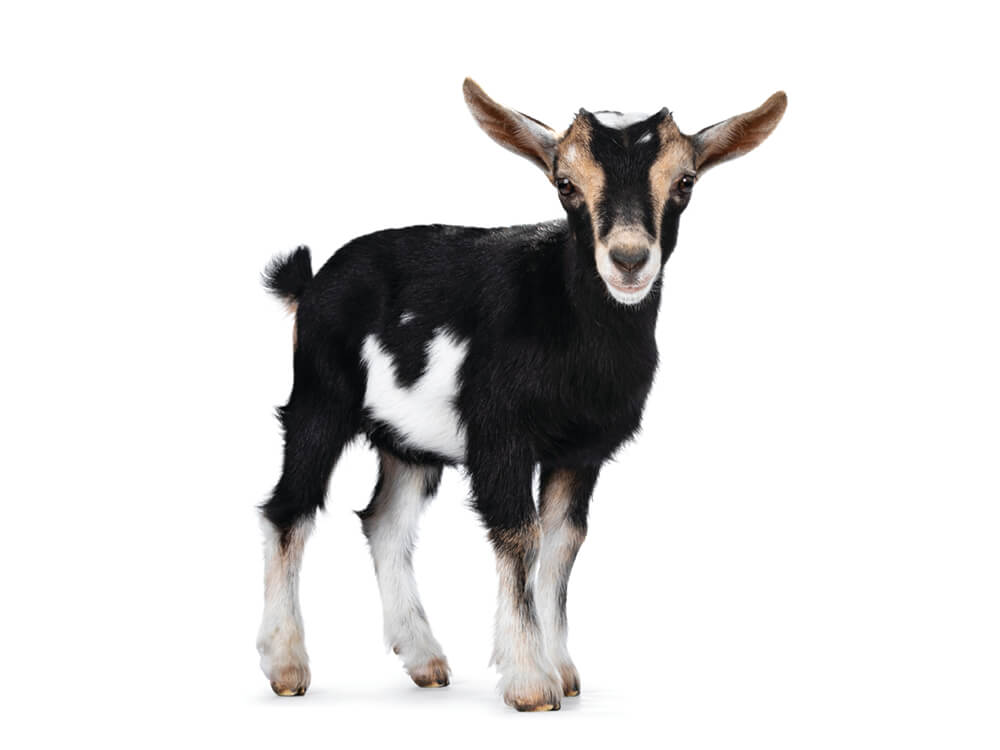
“Goats will eat brush. Sheep will eat some brush, but nothing like goats,” Lynch says. “Goats will clear brush up to 7 or 8 feet tall.”
Goats, which coexist well with sheep, also require similar management, grazing plans and fencing. When run together with sheep, goats can be a smart and easy investment to increase a ranch’s diversity and soil health.
Coffey Ranch, along with the other Noble ranches, will serve as an example of the capabilities of regenerative ranching. Through his limited experience with one flock, Roberts has already noticed positive changes in the ranch’s plants and soil. “If you turn a spade of soil over and look at it, you can already see it improving,” he says. “It’s only been one season, but I am beginning to see the difference already.”
It may just be one flock of sheep so far, but this new endeavor represents another step along the path of regenerative ranching, a path that will change the health of the soil, the plants and the entire outlook of the ranch. Change may not be easy. There are always new lessons and challenges.
Just ask Roberts. Or Lucy and the lambs.


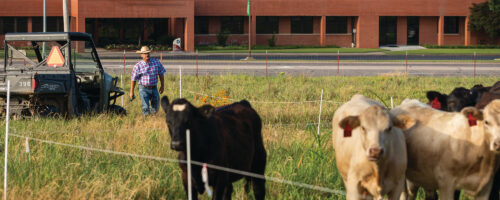
Comment